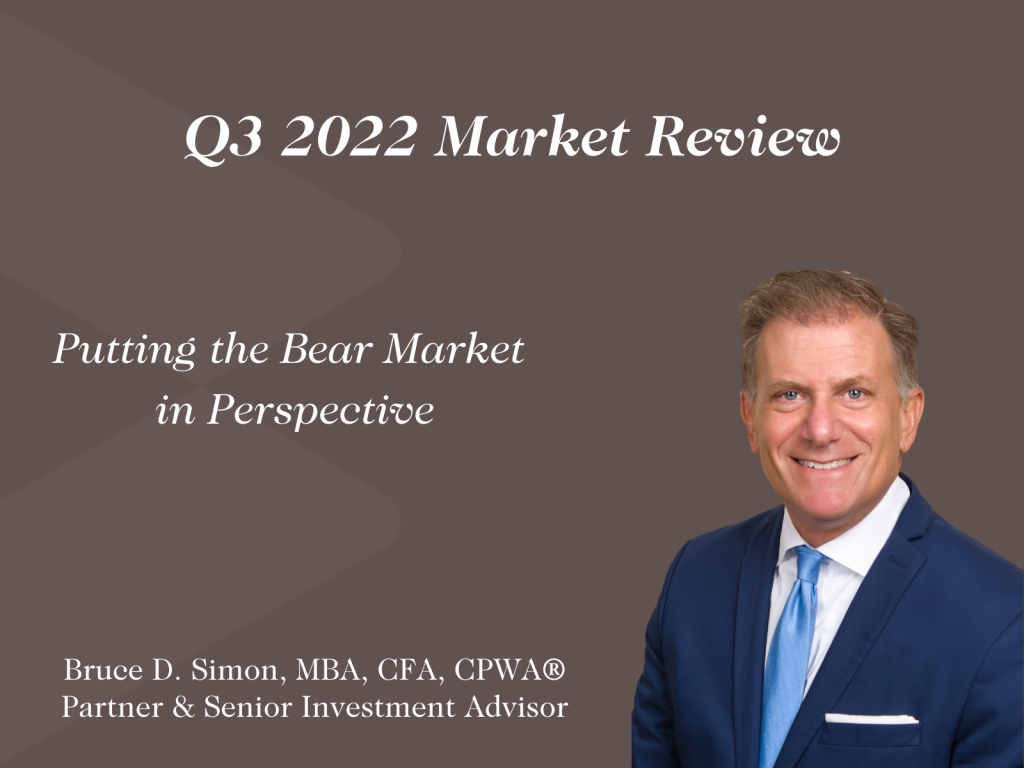(Note: Given the recent market turmoil, we are publishing our quarterly market review before the end of the quarter in order to provide clients with our most current thinking).
A Challenging Year
No doubt this has been one of the most difficult years in memory for many investors. Not only have virtually all equity markets around the world fallen through the traditional bear market threshold of a 20% decline, but the bond market is suffering through its worst stretch in more than 60 years. Even commodities, strong in the early stages of the equity market decline, have begun to roll over. Crude oil has fallen more than 21% this quarter and 34% since its May peak (as of September 27).
By now the cause is well-known: stubbornly high inflation stoked by powerful monetary stimulus during the depths of the pandemic, supply chain disruptions caused by worker shortages, and the availability of near zero borrowing rates (aka “free money”) while inflation pressures were building. Toss in high starting equity valuations, historically low bond yields, and a protracted war in Ukraine, and this combination of causes led to a significant downward adjustment in asset prices.
In its attempt to slay the inflation dragon, the Federal Reserve (and other global central banks) have embarked on a painful yet necessary mission to slow their economies by aggressive fiscal tightening, i.e., raising interest rates. The speed and severity of these rate hikes has convinced many investors that a serious economic recession lies ahead and will result in mass layoffs, loan defaults, and declining corporate earnings. The UK’s recent plan to lower taxes and increase spending by taking on more debt has only worsened fears of higher inflation ahead. Pessimism is rampant as investors rush to protect their portfolios from more losses.
Now What?
We urge clients to avoid getting swept up in the bearishness of the current environment. Nonetheless, investors should be prepared for more weakness. The probabilities of additional declines, even significant ones, are non-trivial. Since 1926, there have been 13 bear markets in equities (excluding the current one). The average duration has been 20 months and the average peak-to-trough decline is -41%: not comforting. But if you eliminate the market crash in 1929 (and the two bear markets that occurred until the market regained its old peak in 1954), the average decline was -35.7% and the average length was 13 months. On that basis, we are approximately 2/3 of the way through the average bear market.
And importantly, we don’t believe we are experiencing the “average” bear market because we don’t believe we are experiencing the “average” recession. As we have written, we believe the US economy is in far better shape than during the last non-COVID inspired downturn. To wit:
- Unemployment, although ticking higher, is starting from a very low base, and job growth remains solid;
- Consumers, businesses, and municipalities have taken full advantage of the historically low rates of the last decade and are in a far stronger position than they were in 2008. And with rising wages, revenues, and tax proceeds, their fixed debt burden is actually shrinking, in a sense, or “inflated away” as economists say;
- While rising rates will no doubt cause some pain, the rates cannot be viewed as too onerous from a historical perspective, as the U.S. economy has weathered much higher rates in the past. Over the past 70 years, the average fed funds rate has been higher more than 60% of the time. Yet the U.S. economy has largely chugged along just fine during these periods.
The Fed’s efforts to subdue inflation will take time to work their way through the economy. To paraphrase former Fed Chairman Paul Volcker, “inflation is not a light switch, it is a dimmer”. Investors need to be patient to see the effects of higher interest rates on slowing the increase in prices. On the flip side, higher interest rates have taken much of the risk out of fixed income investing. Savers can now capture attractive returns on bonds across the yield curve and credit quality spectrum.
While the near-term outlook appears grim, we believe the snapback in equity prices, when it comes, will be surprising and unpredictable. It will begin when the outlook is at its bleakest, when investors have reached maximum pessimism, and when bullish commentators are a lonely bunch. It will be met with initial skepticism from investors sitting on the sidelines. As it picks up momentum, hesitant investors will begin adding to equities, wary of another leg down. Before long, many will recognize that they have missed the most powerful part of the recovery. And unless they were prescient enough to significantly reduce risk in the early stages of the decline, they may be forced to buy back in at prices higher than when they sold.
When the recovery will occur, no one knows, but it is a question of when, not if. In the meantime, while it may be frustrating, the best course of action — particularly for taxable investors who may face a large tax liability if they decide to sell and great uncertainty as to when to buy back in — is to do nothing at all. The stress-testing, Monte Carlo simulations, and strategic asset allocation work that we have done throughout the years certainly anticipated market volatility like this, if not worse. While we know it’s hard to hold your ground when it actually happens, it’s ground worth holding.
About Bruce D. Simon, CFA, CPWA®
Bruce is a Partner and the Director of Research at the firm. In addition to working directly with a number of family clients, Bruce serves on Ballentine’s Investment Management Committee, which is responsible for the oversight of all of the investment activities for the firm.
This report is the confidential work product of Ballentine Partners. Unauthorized distribution of this material is strictly prohibited. The information in this report is deemed to be reliable. Some of the conclusions in this report are intended to be generalizations. The specific circumstances of an individual’s situation may require advice that is different from that reflected in this report. Furthermore, the advice reflected in this report is based on our opinion, and our opinion may change as new information becomes available. Nothing in this presentation should be construed as an offer to sell or a solicitation of an offer to buy any securities. You should read the prospectus or offering memo before making any investment. You are solely responsible for any decision to invest in a private offering. The investment recommendations contained in this document may not prove to be profitable, and the actual performance of any investment may not be as favorable as the expectations that are expressed in this document. There is no guarantee that the past performance of any investment will continue in the future.




